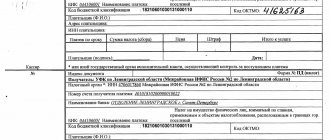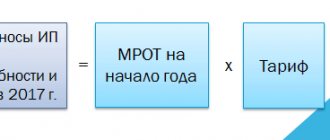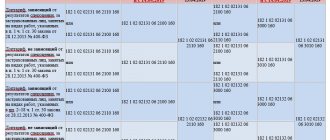The instruction on the use of new budget classification codes (BCC) from January 1, 2005 was approved by Order of the Ministry of Finance of Russia No. 72n dated August 27, 2004. And in accordance with the Directive of the Bank of Russia dated August 25, 2004 No. 1493-U “On the specifics of using settlement document formats when making electronic payments through the Bank of Russia settlement network,” the maximum length of field 104 of a settlement document has been increased to 20 characters.
KBK (field 104) are budget classification codes filled in field 104 of the payment order. For each type of tax, the payment order indicates its own budget classification code (BCC). The maximum length of field 104 (KBK) of the settlement document has increased to 20 bits (characters).
The maximum number of BCC characters entered in detail 104 (field 104) is determined to be 20, and this is specified in Appendix 11 to Bank of Russia Regulations dated June 19, 2012 N 383-P “On the rules for transferring funds.”
And the very meaning of the BCC can always be clarified using the Table of Codes for Classifying Budget Revenues of the Russian Federation, administered by the Federal Tax Service, which is given in the letter of the Federal Tax Service of the Russian Federation dated December 16, 2005 No. MM-6-10 / [email protected]
The structure of the budget income classification code of the Russian Federation (KBK) consists of 20 categories, combined into 4 parts, and has the following form:
| Rank | 1 | 2 | 3 | 4 | 5 | 6 | 7 | 8 | 9 | 10 | 11 | 12 | 13 | 14 | 15 | 16 | 17 | 18 | 19 | 20 |
| Parts | 1 | 2 | 3 | 4 | ||||||||||||||||
| Code name | Administrator | Group | Subgroup | Article | Sub-article | Element | Program | Economic classification | ||||||||||||
Let us consider the structure of the budget classification of income code (KBK) of the Russian Federation in more detail.
KBK structure
The BCC consists of 20 digits, each group of digits is responsible for its specific part (administrative, revenue, program, and classifying part)
- The first three digits are the profit administrator.
- One digit code—income groups.
- Two numbers—type of income.
- Five figures—item and subitem of income.
- Two numbers—budget level.
- The penultimate three digits indicate how the income was collected.
- The last three digits are the type of economic income.
It would be clear with the usual KBK codes which, for example, look like this—182 1 0100 110 (this is income tax for transfer to the Federal Budget). What is this KBK 00000000000000000130 ? Some accountants of organizations are faced with such BCC. Where are the amounts of money transferred using this information?
The list of KBK is very large; there is a special directory where all the codes for transferring to the state treasury are entered. For each code, Russian legislation defines its own expense items for transferring amounts for certain operations. For example, Article 226 of the BC RF provides a list of services and works that relate to BCK 000000000000000000130 in 2021. Let’s look at what this is below.
Explanations
- Administrator
- Type of income (group, subgroup, article, subitem, element)
- Subtype of budget revenues (group and analytical group)
The administrator consists of three characters and determines the revenue administrator code. Administrators, for example, are the Federal Tax Service (code 182), the Social Insurance Fund (code 393), the Pension Fund (code 392)
The type of income is the same for all budgets of the country and includes:
- group
- subgroup
- article
- sub-article
- element (defines the type of budget).
The income group has the following meanings:
- 100 - tax and non-tax revenues;
- 200 - gratuitous receipts.
Group 100 “Tax and non-tax income” (and we are only interested in this in this article) contains the following subgroups of income:
- 101 - taxes on profits, income;
- 102 — insurance contributions for compulsory social insurance;
- 103 - taxes on goods (work, services) sold on the territory of the Russian Federation;
- 104 - taxes on goods imported into the territory of the Russian Federation;
- 105 - taxes on total income;
- 106 — property taxes;
- 107 - taxes, fees and regular payments for the use of natural resources;
- 108 - state duty;
- 109 - debt and recalculations for canceled taxes, fees and other obligatory payments;
- 110 - income from foreign economic activity;
- 111 - income from the use of property in state and municipal ownership;
- 112 - payments for the use of natural resources;
- 113 - income from the provision of paid services (work) and compensation of state expenses;
- 114 - income from the sale of tangible and intangible assets;
- 115 - administrative fees and charges;
- 116 - fines, sanctions, compensation for damage;
- 117 - other non-tax income;
- 118 - receipts (transfers) for the settlement of settlements between budgets of the budget system of the Russian Federation.
BC RF art. 226
Based on the instructions of the Russian Federation on the application of the BCC in Art. 226 includes the following types of service provision:
- Research works.
- Engineering and technical services, conducting structural surveys.
- Demarcation of land boundaries.
- Standard design.
- Installation work. Installation of systems such as video surveillance, panic buttons.
- Providing insurance services.
- Ensuring security during secret events.
- Providing services for the protection of electronic document management.
- Typographic works (binder services, photocopying).
- Medical services.
- Collection services.
- Provision of paid vocational training services.
- Services provided to the organization for food for employees.
- Another similar range of services.
Kbk (budget classification codes) for 2018: table with decoding
Russian Federation 04 For goods sold outside Russia, import 05 For income 06 Payment of a property nature 07 From persons who use the subsoil 09 Duty to the state 09 Penalty or penalty 10 Profit received from an export or import operation 11 Income from property of the state, which rented out for use 12 Contribution for the use of subsoil 13 Income from the use of government services 14 Profit from the sale of goods 15 Fine or other fee 16 Compensation for losses The administrators from whom the proceeds come are considered to be:
- tax authorities;
- other state bodies;
- management bodies of extra-budgetary funds;
- local government;
- Individuals and legal entities.
The software part consists of 4 digits indicating the type of payment - 100 (duty), 2000 (fine), fine (3000).
Revenue code structure
| 1 | 2 | 3 | 4 | ||||||||||||||||
| Chief Budget Revenue Administrator | Budget income type code | Budget income subtype code | |||||||||||||||||
| Income subtype group | Analytical group of income subtype | ||||||||||||||||||
| Group | Subgroup | Article | Sub-article | Element | |||||||||||||||
| 1 | 2 | 3 | 4 | 5 | 6 | 7 | 8 | 9 | 10 | 11 | 12 | 13 | 14 | 15 | 16 | 17 | 18 | 19 | 20 |
Budget classification codes (KBK) for 2018
KBC table for 2021: budget classification codes with decoding These magical three letters, which mean nothing to ordinary citizens, regularly create headaches for entrepreneurs. As KBK KBK stands for - the budget classification codes KBK of organizations, necessary for the payment to go where it was intended, change almost every year. And the responsibility for their correct indication lies with the payer! Let's try to figure out what these mysterious codes are, why they are needed, how they are formed and why they change regularly. We will also tell you what to do if you find an error in the specified code, and what you risk in this case, and most importantly, how to prevent This risk is not to end up with accrued fines and penalties if taxes and fees are paid on time.
Budget classification codes (kbk) for 2019
- Budget classification code 000000000000000000130
- What is kbk in a payment system in 2021
- Let's learn how to fill out a payment order: what is kbk in a payment order?
- KBC table for 2021: budget classification codes with decoding
- How to correctly fill out the kbk field in a payment order
- Budget classification codes (kbk) for 2021
- Budget classification codes 2018
- Kbk 0000000000000130 what is this for
Budget classification code 00000000000000000130 Attention Where are the amounts of money transferred using this detail? The list of KBK is very large; there is a special directory where all the codes for transferring to the state treasury are entered. For each code, Russian legislation defines its own expense items for transferring amounts for certain operations.
Kosgu 2018: all changes in one table
For example, the payment slip indicated the KBK for the funded portion of the pension, but they intended to pay for the insurance portion. In such cases, contributions are still considered to have been made on time, and you must proceed in the same way as under the usual procedure.
The court can help with any problems with a fund that refuses to make a recalculation, and an illegal demand for payment of arrears and the accrual of penalties. REMEMBER! According to the law, an error in the KBK is not a reason for which the payment will not be considered transferred. The payment order contains additional information indicating the purpose of the payment and its recipient, therefore, if it is indicated correctly, there is and cannot be a reason for penalties against the entrepreneur; other decisions can be challenged in court.
Thus, there is in fact no delay in mandatory payment, which involves penalties. Budget Classification Codes (KBK) for 2021 According to the legislation of the Russian Federation, a payment order is a document on the basis of which banks can transfer non-cash funds. The unified form of this document is approved by law and, when filling it out, certain information is required to be entered in each column to explain the purpose of the payment. What is KBK in a payment order Concept and features An example of such information is the budget qualification code (KBK), which to the uninitiated eye looks like a meaningless set of numbers, and, in fact, carries a lot of information. A payer who does not understand how this code is deciphered , will not be able to fill out the form correctly, which can lead to serious problems.
Nameplate: appearance requirements
The sign must be rectangular in shape only. Recommended dimensions: 200*100 mm (not less). The title and other information are applied with a special cutter. Unclear outlines or blurriness are not allowed. List of conditions that must be fulfilled:
- The height of letters and numbers is 5 mm.
- The material of manufacture (with rare exceptions) is COR-TEN steel.
- The starting material must be non-flammable. Its qualities: corrosion resistance, strength, resistance to scratching. The reaction to interaction with chemicals is neutral.
- Mandatory data: imprint of the Register stamp, exact time of examination by inspectors of the supervisory authority.
The CSC must be located away from permissible sources of mechanical impact. If damage is nevertheless caused, the plate is replaced, but the relevant qualification body is notified about this.
Kbk 0000000000000130 in 2018
The article will talk about KBK. What is it, why is the code needed, and where to look for it - further. When transferring funds to the budget, you must correctly fill out the payment order, indicating the code.
- Basic points
- What is KBK in a payment order?
- Emerging nuances
There are some changes in 2021 that you need to be aware of in order to avoid mistakes when filling out.
KBK is one of the main details that is entered by the payer when transferring a tax payment or other. It consists of numbers arranged in a certain sequence. Thanks to the sequence, you can find out where the payment came from, what its purpose is and other information. Funds that are allocated to the state budget must be distributed correctly. KBK will help simplify the task.
Customs Convention on Containers Done at: Geneva Date adopted: 1972-12-02 In force: 1975-12-06
Appendix 6
Explanations
Introduction
| I. | In accordance with the provisions of Article 13 of this Convention, the explanatory notes contain the interpretation of certain provisions of this Convention and its annexes. |
| II. | The explanatory notes do not change the provisions of this Convention or its annexes, but their content, meaning and scope. |
| III. | In particular, taking into account the principles set out in accordance with the provisions of Article 12 of this Convention and Annex 4 thereto for the approval of containers for carriage under Customs seals, the explanatory notes contain, in appropriate cases, instructions on constructive measures to be accepted by the contracting parties as complying with these provisions . The explanatory notes may also indicate which construction methods, if any, do not comply with these provisions. |
| intravenously | The Explanatory Notes provide a means of applying the provisions of this Convention and its annexes in accordance with developments in technology and economic requirements. |
Main text of the Convention
Article 1, subparagraph (c) (i) - partially closed containers
1 (c) (I) -1
The term "partially enclosed" in relation to equipment in Article 1, subparagraph (c)(i) refers to equipment usually consisting of a floor and an upper structure forming a loading space equivalent to a closed container. The top structure usually consists of metal members that form the frame of the container. Containers of this type may also include one or more side or end walls. In some cases there is only a roof attached to the floor by posts. This type of container is used, in particular, for transporting bulky goods (passenger cars, for example).
Sub-clause (d) - Equipment and materials of the container
1 (s) -1
The term "container trim and accessories" will cover in particular the following devices, even if they are removable:
| . | equipment for controlling, modifying or maintaining the temperature inside the container; |
| b. | small household appliances such as temperature or impact recorders designed to indicate or record changes in environmental conditions and exposure; |
| With. | internal partitions, trays, shelves, racks, hooks, and similar devices used for stowing goods. |
4. Appendix 4
4.2 of Article 2 Sub-clause 1 (a) - Assembly of components
4.2.1. (A) -1
| . | Where fasteners (rivets, screws, bolts and nuts, etc.) are used, a sufficient number of such parts must be inserted from the outside, pass through the fastened elements, protrude inside and be firmly fixed there (for example, riveted, welded, bushings, bolts and rivets or welding nuts). However, ordinary rivets (i.e. rivets that are placed on both sides of the assembled assembly) can also be inserted from the inside. Notwithstanding the foregoing, container floors may be attached using self-tapping screws or self-drilling rivets or rivets inserted by means of an explosive charge, when placed from the inside and extending vertically through the floor and metal cross-piece below, provided, except in the case of self-tapping screws, that some of their ends will be flush with the outer part of the cross or will be welded to it. |
| b. | The competent authority shall determine which fasteners, and how many of them, must comply with the requirements of subparagraph (a) of this note; they must do this by ensuring that the constituent elements are assembled so that they cannot be dislodged without leaving visible marks. The selection and placement of other fasteners is not subject to any restrictions. |
| With. | Fasteners that can be removed and replaced on one side without leaving visible marks, i.e., without requiring components to be carried out on both sides for assembly, are not permitted under subparagraph (a) of this note. Examples of such parts are expansion rivets, blind rivets and the like. |
| G. | The assembly methods described above apply to special containers, such as insulated containers, refrigerated containers and tank containers, to the extent that they do not conflict with the technical requirements that such containers must meet in view of their use. Where, for technical reasons, it is not possible to fasten the component elements in the manner specified in subparagraph (a) of this note, the component elements may be connected using the parts described in subparagraph (c) of this note, provided that the connecting devices used on the internal wall surfaces cannot be tampered with from the outside. |
Sub-clause 1 (b) - Doors and other closing systems
4.2.1. (B) -1
| . | The device on which customs seals can be affixed must: (I) | be attached by welding, or at least two fasteners, in accordance with subparagraph (a) of explanatory note 4.2.1 (c) -1;. or |
| (II) | be designed in such a way that, when the container has been closed and sealed, the device cannot be removed without leaving visible traces; or | |
| (III) | have holes with a diameter of at least 11 mm in diameter or slots with a length of at least 11 mm in length by 3 mm in width. |
Sub-clause 1 (c) - Ventilation openings
4.2.1. (C) -1
| . | Their maximum size should, in principle, not exceed 400 mm. |
| b. | Openings giving direct access to goods must be covered with wire mesh or perforated metal screen (with maximum opening size: 3 mm in both cases) and protected by welded metal grating (with maximum opening size 10 mm). |
| With. | Openings that do not provide direct access to the goods (for example, due to the presence of an elbow system or a deflector system) must be equipped with the same devices, in which, however, the opening dimensions can be as much as 10 mm and 20 mm, respectively. |
| G. | Where openings are made in the tarpaulin, the devices referred to in subparagraph (b) of this note should in principle be prescribed. However, blocking devices in the form of a perforated metal screen placed outside and wire or other mesh placed inside will be permitted. |
Sub-clause 1 (c) - Drainage holes
4.2.1. (C) -2
| . | Their maximum size should, in principle, not exceed 35 mm. |
| b. | Openings providing direct access to goods must be provided with the devices prescribed in subparagraph (b) of Explanatory Note 4.2.1. (C) -1 for vents. |
| With. | In cases where drainage holes do not provide direct access to the goods, the device of which is stated in subparagraph (b) of this note, devices are not required, provided that the holes are equipped with a reliable partition system that is easily accessible from the container. |
4.4 Article 4 Clause 3 - Tarpaulin made up of several pieces
4.4.3.-1
| . | The individual pieces making up one tarpaulin may be made of various materials satisfying the provisions of Annex 4, Article 4, paragraph 2. |
| b. | Any arrangement of pieces that provides sufficient assurance of safety will be permitted in the manufacture of tarpaulins, provided that the pieces are joined in accordance with the requirements of Annex 4 of Article 4. |
Sub-clause 6(a)
4.4.6. (A) -1
Examples of a construction system for placing container sheets and a system for fastening tarpaulin to container corner fittings, acceptable from a customs point of view, are given in sketches No. 1, No. 2 and No. 3 to this appendix.
Item 8 - Textile powder fastening ropes
4.4.8-1
For the purposes of this paragraph, a cable having a textile core surrounded by six strands of steel wire completely covering the core will be permitted provided that the diameter of the cables (excluding clear plastic sheathing, if any) is not less than 3 mm in diameter.
Sub-clause 10(c) - Sheet thong
4.4.10 (c) -1
The following materials are considered suitable for the manufacture of belts:
| . | leather; |
| b. | textile materials, including plastics fitted with a device or rubberized fabric, provided that such materials can not be welded or repaired after a weekend without leaving visible marks. |
4.4.10. (C) -2
The device shown in Figure No. 3 to this Annex meets the requirements of the last part of paragraph 10 of Article 4 of Annex 4. It also meets the requirements set out in Annex 4 of Article 4, paragraph 6.
5. Appendix 5
5.1 Clause 1 - Approval of a combination of canvas containers
5.1-1 If two canvas-covered containers approved for transportation under Customs seals are joined in pairs in such a way that they form one container, covered with one canvas and meeting the requirements for transportation under Customs seals, a separate certificate of approval or Plaque assumption, not required for combination.
Kbk 0000000000000130 in 2018 what is it
- 15 — fines and fees;
- 16 – payment of damage.
The program group specifies the payment option:
- 110 – taxation of income;
- 160 – public payments;
- 151 - profit from budget recombination;
- 152—receipts from third parties;
- 153 — financing by foreign credit institutions;
- 170 – earnings from trading;
- 171 – income from property revaluation;
- 172 - income from property recycling;
- 180 – other income.
The BCC for insurance premiums is described in the video below: Sample filling Note that the BCC must be indicated not only for tax revenues, but also in other cases, for example, tuition fees look like this: 0000000000000130.
| Payment receiver: | in the Department of Financial Institutions for the Novosibirsk Region (NYUI(f) TSU, l/s 30516Shch46040 | ||
| Taxpayer Identification Number: | 7018012970 | ||
| Checkpoint: | 540702001 | ||
| Account number: | 40501810700042000002 | ||
| in the bank: | Municipal PJSC "Khanty-Mansiysk Bank Otkritie" | ||
| BIC: | 045004001 | ||
| Corr. check: | 30101810300000000985 | ||
| KBK: | 00000000000000000130 | ||
| OKTMO: | 50701000 | ||
| “KBK (income code) 00000000000000000130 from the provision of paid educational services under agreement No. 543 dated August 30, 2016. for studying" | in the UFC for the Novosibirsk region (NYUI(f) TSU | ||
Municipal entities of the Novosibirsk region → Urban districts of the Novosibirsk region → City of Novosibirsk Translate OKTMO 50701000 to OKATO
Print receipt
Register and get the opportunity to save forms (for auto-filling) of receipts you create. After registering and saving the form, a list of your saved forms will appear in this place.
Do you want a blank payment receipt form for your website? Just copy the code to paste it onto the website.
Receipt form for the site with the above details









